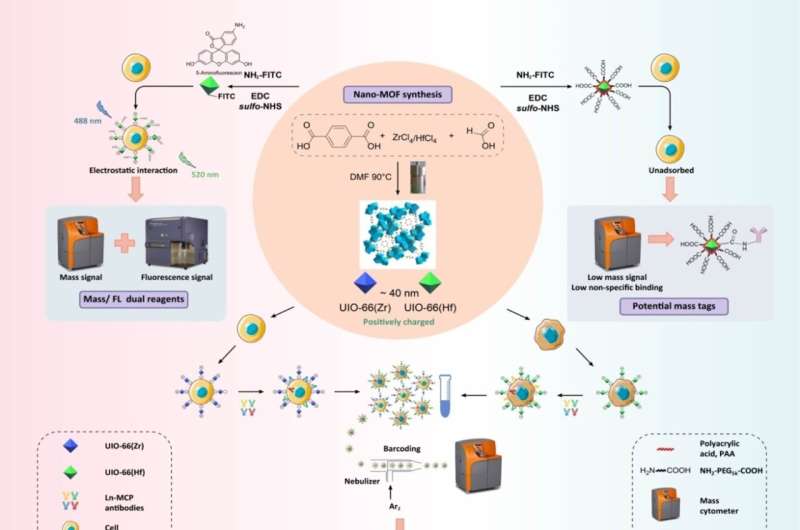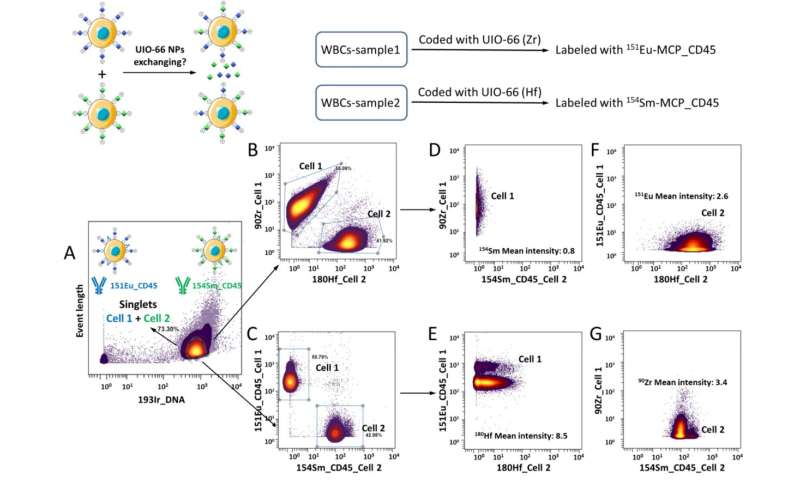This article has been reviewed according to Science X's editorial process and policies. Editors have highlighted the following attributes while ensuring the content's credibility:
fact-checked
peer-reviewed publication
trusted source
proofread
Mass cytometry barcoding strategy offers a new perspective of non-specific binding

Non-specific binding (NSB), the most annoying thing to scientists in the biosensing field, is one of the main factors limiting the performance of diagnostic sensors.
Researchers from the Suzhou Institute of Biomedical Engineering and Technology (SIBET) of the Chinese Academy of Sciences propose a novel mass cytometry barcoding strategy based on UIO-66(Hf/Zr) typed metal organic framework (MOF) utilizing its non-specific binding to cells.
The research, titled "New perspective of non-specific binding: a powerful mass cytometry barcoding strategy based on UIO-66(Hf/Zr) typed MOF utilizing its strong positive charge," was published in Chemical Engineering Journal.
Nanoparticle-based metal tags can increase mass cytometry signal intensity but usually result in severe NSB with cells, limiting its application in mass cytometry. A variety of methods have been developed to overcome the issues caused by NSB and increase the sensitivity and selectivity of biosensors.
"By understanding the mechanisms of nonspecific interactions, NSB can also play a positive role in biomedical engineering under certain circumstances," said Professor Bai Pengli, leading scientist of the team.
Profiting from the nine abundant stable isotopes of Zr and Hf, the team can achieve up to 84 mass barcode combinations theoretically through the non-specific binding between positively charged UIO-66 and negatively charged cells.
-

Barcoding strategy and debarcoding with single typed UIO-66. Credit: SIBET -

(A) The t-distributed stochastic neighbor embedding (t-SNE) dot plots depict protein expression of 9 surface markers of 50,000 single WBCs stained with MCP mass tags (n = 50,000 individual cells). Color bars range from blue to red, with red indicating elevated expression levels; a) unbarcoded, b) UIO-66(Zr) barcoded and c) UIO-66(Hf) barcoded. (B) The corresponding heatmap; (C) Contour plots of CD4+/CD8+ T cells populations with and without UIO-66 barcoding. Credit: SIBET
Researchers obtained clearly distinguished individual population sets when the cell samples were barcoded with UIO-66(Zr) and UIO-66(Hf). This is the first universal cell surface barcoding strategy for mass cytometry independent of particular cell surface molecules.
The UIO-66 barcoding showed high compatibility with metal chelated polymer (MCP) mass tags in single-cell multiplexing. The t-distributed stochastic neighbor embedding (t-SNE) contour plots revealed that UIO-66(Zr) and UIO-66(Hf) barcoding did not interfere with all the rare earth isotope channels chosen for MCP antibody tags in this experiment.
The protein expressions of white blood cells (WBCs, or leukocytes) before and after UIO-66 barcoding did not show significant difference.
"Our work will offer another perspective to NSB occurring in the biological field and provide a potential opportunity to those materials which were abandoned due to NSB," said Bai.
More information: Zhizhou Liu et al, New perspective of non-specific binding: A powerful mass cytometry barcoding strategy based on UIO-66(Hf/Zr) typed MOF utilizing its strong positive charge, Chemical Engineering Journal (2024). DOI: 10.1016/j.cej.2024.154118
Journal information: Chemical Engineering Journal
Provided by Chinese Academy of Sciences




















